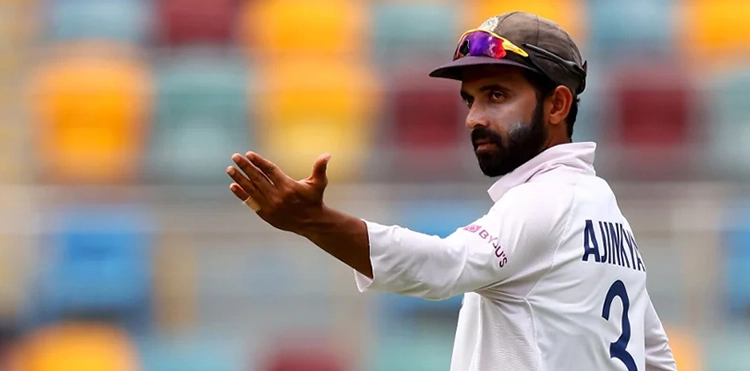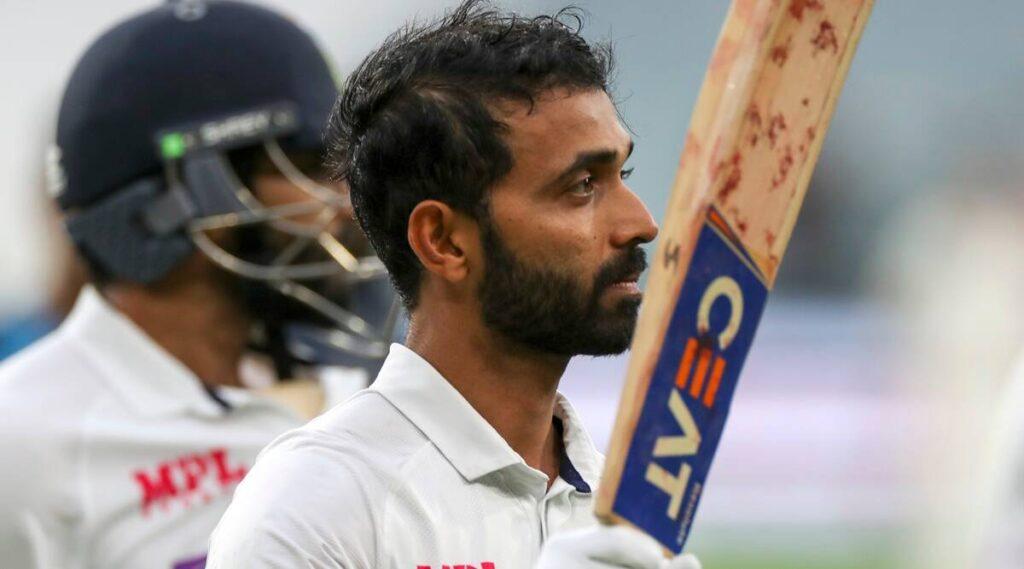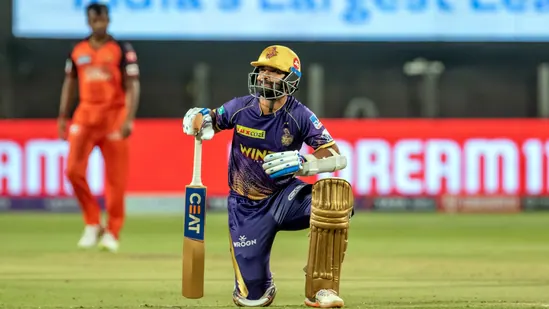Ajinkya Rahane, originally from the Dombivli suburb of Mumbai, was born into a middle-class family that wholeheartedly supported his love for cricket.
Personal Information
| Name | Ajinkya Rahane |
| Born | Jun 06, 1988 (34 years) |
| Birth Place | Ashwi-KD, Maharastra |
| Height | 1.68M |
| Role | Batsman |
| Batting Style | Right – Handed Bat |
| Bowling Style | Right-Arm Medium |
ICC Ranking
| Role | Test | ODI | T20 |
| Batting | – | – | – |
| Bowling | – | – | – |

Career Information
| Teams | Mumbai, Board Presidents XI, Rajasthan Royals, India, India A, Rest of India, West Zone, Indians, Mumbai Indians, Rising Pune Supergiant, India C, Hampshire, Delhi Capitals, Kolkata Knight Riders, Chennai Super Kings |
Batting Career Summary
| M | INN | NO | Runs | HS | Avg | BF | SR | 100 | 200 | 50 | 4s | 6s | |
| Test | 82 | 140 | 12 | 4931 | 188 | 38.52 | 9972 | 49.45 | 12 | 0 | 25 | 561 | 34 |
| ODI | 90 | 87 | 3 | 2962 | 111 | 35.26 | 3767 | 78.63 | 3 | 0 | 24 | 293 | 33 |
| T20I | 20 | 20 | 2 | 375 | 61 | 20.83 | 331 | 113.29 | 0 | 0 | 1 | 32 | 6 |
| IPL | 158 | 148 | 16 | 4074 | 105 | 30.86 | 3376 | 120.68 | 2 | 0 | 28 | 431 | 80 |
Bowling Career Summary
| M | INN | B | Runs | Wkts | BBI | BBM | Econ | Avg | SR | 5W | 10W | |
| Test | 82 | – | – | – | – | – | – | – | – | – | – | – |
| ODI | 90 | – | – | – | – | – | – | – | – | – | – | – |
| T20I | 20 | – | – | – | – | – | – | – | – | – | – | – |
| IPL | 158 | 1 | 6 | 5 | 1 | 1/5 | 1/5 | 5.0 | 5.0 | 6.0 | 0 | 0 |
Career Information
| Test Debut | vs Australia at Arun Jaitley Stadium, Mar 22, 2013 |
| Last test | vs South Africa at Newlands, Jan 11, 2022 |
| ODI debut | vs England at Riverside Ground, Sep 03, 2011 |
| Last ODI | vs South Africa at SuperSport Park, Feb 16, 2018 |
| T20 debut | vs England at Emirates Old Trafford, Aug 31, 2011 |
| Last T20 | vs West Indies at Central Broward Regional Park Stadium Turf Ground, Aug 28, 2016 |
| IPL debut | vs Deccan Chargers at Dr DY Patil Sports Academy, Apr 27, 2008 |
| Last IPL | vs Sunrisers Hyderabad at Maharashtra Cricket Association Stadium, May 14, 2022 |
Profile
In the post-Tendulkar era of Indian cricket, the dressing room is filled with players sporting tattoos, styled hair, peroxide highlights, and the trendy dabbing moves. This vibrant and youthful atmosphere is the norm. However, amidst all the glitz and glamour, there was an unexpected outlier – a quiet and unassuming young man of shorter stature.
Ajinkya Rahane, originally from the Dombivli suburb of Mumbai, was born into a middle-class family that wholeheartedly supported his love for cricket. Despite limited resources, Rahane began his cricket journey on a matted wicket in Dombivli and later started training with Pravin Amre at the age of 17.
Rahane, known for his impeccable character, embraced cricket with unwavering dedication, treating it like a religion. He swiftly climbed the ranks of junior cricket and made his mark in the Ranji Trophy. In his second season, Rahane showcased his brilliance by amassing an impressive 1089 runs, catching the attention of selectors. However, the Indian batting lineup was already packed with talent, leaving little room for the young cricketer. Nevertheless, Rahane continued to excel in the Ranji Trophy, breaking records and consistently scoring centuries.
In his first encounter with international bowlers, Rahane emerged victorious, scoring an impressive 172 in a Duleep Trophy match against renowned England players such as Liam Plunkett and Graham Onions.
Rahane further showcased his undeniable talent by delivering exceptional performances in the emerging players’ tournament in Australia, where he scored two centuries, proving his worth even in challenging conditions. This reminded observers of another talented young cricketer from Mumbai in 1992, who also possessed a powerful technique and had a fondness for Australian pitches.
Following his exceptional performance in Australia, Ajinkya Rahane gained significant recognition at the national level. The timing couldn’t have been better, as in August 2011, the Indian limited overs team was facing a desperate situation after losing the Test series 0-4 in England. With several players struggling with form and injuries, Rahane was called in as a replacement for the T20Is against England.
He immediately made an impact as an opener, scoring a fluent 61 on his T20I debut and 40 on his ODI debut, demonstrating his adaptability and reliability. His compact technique proved crucial in handling late movement, setting him apart from some of his technically weaker teammates. However, once the regular players returned for the home season, Rahane found himself on the bench for a few months.

After the retirement of esteemed players such as VVS Laxman and Rahul Dravid, the Indian selectors began the important task of introducing young talents to the international stage. Despite spending a year in and out of the team and enduring 16 months on the bench, Ajinkya Rahane’s opportunity finally arrived when Shikhar Dhawan suffered an injury. This led to Rahane receiving the highly coveted Test cap number 278, a significant milestone in Indian cricket.
After a disappointing debut in Test cricket, Ajinkya Rahane began to establish himself as India’s most versatile and indispensable player, particularly excelling in foreign conditions. On Boxing Day 2013, he entered the Kingsmead ground with India at 199-4. Despite a collapse in the lower order, Rahane displayed remarkable resilience, batting alongside the tailenders and finishing unbeaten on 51*.
He faced the formidable challenge of countering Dale Steyn, Morne Morkel, and Vernon Philander on a challenging pitch, ultimately helping India reach a first-innings total of 334. In the second innings, with India struggling at 71-4 and still trailing by 95 runs, Rahane played a fluent innings of 96, single-handedly rescuing his team and ending their drought of away victories. Although South Africa managed to secure a small lead of 58 runs, Rahane’s efforts ensured that they had to bat again. Despite India ultimately losing the match and the series, they had discovered a true gem in Rahane, a player who excelled in overseas conditions.
Rahane’s batting skills were truly remarkable, showcasing his technical expertise, balance, and compact technique. He displayed exceptional control over his drives, effortlessly restraining them and playing with a late touch, without relying heavily on the wristy bottom-hand drive. This was a quality that was often missing in many batsmen from the subcontinent during his generation. Rahane’s pronounced forward movement and front-on stance played a crucial role in his ability to handle short-pitched deliveries effectively, a skill that many of his fellow players lacked.
During India’s away season in 2013/14, Ajinkya Rahane established himself as one of India’s most accomplished batsmen overseas, alongside Murali Vijay. After missing out in Durban, he achieved his maiden century in Wellington on the New Zealand tour, showcasing his skills on a challenging seaming surface. In a crucial match at Lord’s, on a pitch favoring seam movement, Rahane played a composed innings of 103, leading India to their first victory at Lord’s in 28 years and their first significant overseas win since Perth 2008. His performance earned him a place on the honours board.
Throughout the series, Ajinkya Rahane consistently displayed superior technical skills compared to his teammates, acting as a solid anchor during the challenging English conditions in the last three Tests. He concluded the year with a magnificent 147 on the lively MCG pitch during the Boxing Day Test against Australia, forming a remarkable 262-run partnership with Virat Kohli. This exceptional performance, combined with his earlier 81 on a seaming track at the Gabba, further solidified his reputation as a dependable presence in the Indian middle-order.
Following his century at Kingston in August 2016, Ajinkya Rahane had achieved the remarkable feat of scoring a hundred in every Test-playing nation he had played in, with the exception of South Africa where he had scored 96, and Bangladesh where he had scored 98. Despite having an outstanding away record compared to his peers, Rahane surprisingly struggled to perform well at home. However, he silenced all the doubters by displaying his batting prowess in the Delhi Test against South Africa in 2015, where he scored two centuries. This exceptional performance played a crucial role in securing a dominant series victory against the Proteas.
While Ajinkya Rahane remains a crucial member of the Test team, his presence in the ODI side has been inconsistent. Nonetheless, he performed well enough to earn a spot in the 2015 World Cup in Australia, where he made a significant contribution in the middle-order. Notably, he played a vital innings of 79 against South Africa, helping India secure their first World Cup victory against them. However, he was later dropped from the ODI team due to a high dot-ball percentage towards the end of 2015. Since then, Rahane has primarily focused on Test cricket and has become a specialist in that format for India.
Although he occasionally gets opportunities in ODIs as a replacement for injured players, he has made the most of these chances. In fact, he was the highest run-scorer in the ODIs during India’s tour of the West Indies in mid-2017. However, with the return of Rohit Sharma, Rahane found himself out of the ODI side again due to limited spots and the established opening pair of Shikhar Dhawan and Rohit Sharma.
Nevertheless, Rahane remains a crucial batsman for the IPL franchises he has represented, including the Mumbai Indians, Rajasthan Royals, and currently, the Rising Pune Supergiant.
During the 2017/18 Ranji Trophy season, Ajinkya Rahane experienced a slight decline in form, which was unusual for Mumbai as they failed to progress beyond the quarter-final stage. This dip in form was evident when Ajinkya Rahane scored his first duck in Ranji cricket since 2008. Unfortunately, his poor form persisted for a concerning period of time, as he struggled to make any notable contributions during the home series against a Sri Lankan bowling lineup that was not particularly strong.
Following a period of struggle where Ajinkya Rahane went 15 Tests without scoring a century, he was omitted from the Indian team after the away series in South Africa in 2022.
IPL through the years
During the initial years of his career, Ajinkya Rahane played for the Mumbai Indians, his hometown team. As a rookie player without an official cap, he didn’t get many opportunities to showcase his skills. However, when he joined the Rajasthan Royals, Ajinkya Rahane started to display consistent performances in the Indian Premier League (IPL). He proved to be a reliable opener who could find gaps in the Powerplay and build on that momentum.

Ajinkya Rahane became an integral part of the Royals’ batting lineup, around which their strategy revolved. In the 2012 season, he had a breakthrough year, scoring over 550 runs with an impressive strike rate, and even achieving his first IPL century. From 2012 to 2016, Rahane established himself as one of the most dependable players in the history of the tournament.
In recent years, Ajinkya Rahane’s performance has experienced a decline. The 2017 season was particularly challenging for him, as he faced struggles throughout the tournament. It turned out to be his worst performance since 2014, despite being an experienced cricketer.
The following year, in 2018, Ajinkya Rahane faced additional difficulties due to the added responsibility of captaincy. While he initially opened the innings for a significant portion of the tournament, his form became a concern. As a result, he made the decision to shift to the number three position, allowing the more aggressive Rahul Tripathi to partner with Jos Buttler at the top.
Also Read: Ajinkya Rahane & TATA IPL 2023 Players List
Get IPL 2023 Live Score along with Points Table & Schedule Updates at IceCric.News and Follow for Live Updates – Twitter, Facebook & Instagram.




